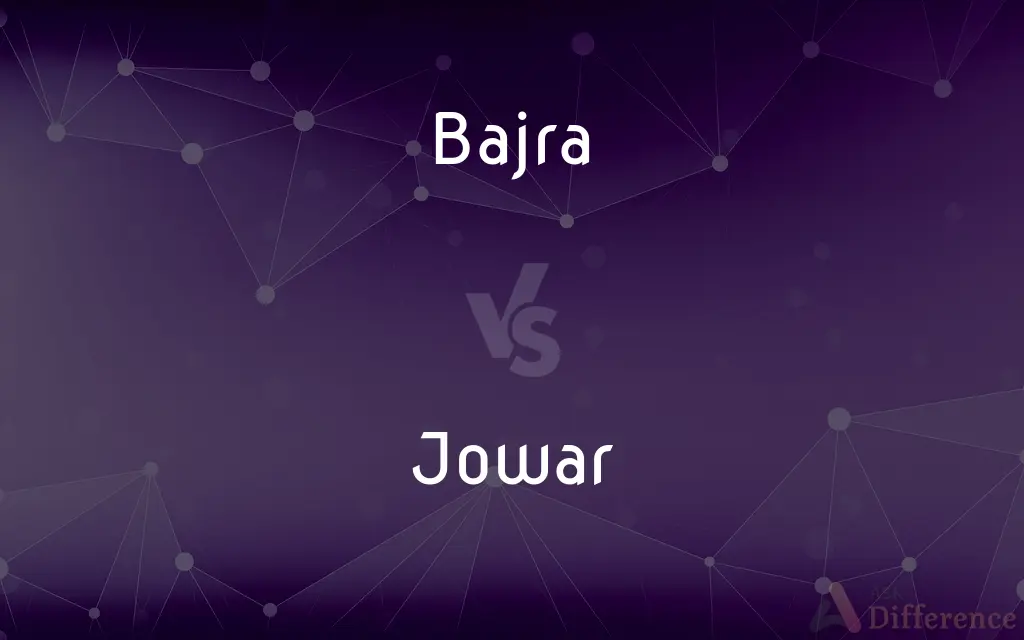Bajra vs. Jowar — What's the Difference?
By Tayyaba Rehman — Published on January 21, 2024
Bajra (pearl millet) and Jowar (sorghum) are both nutritious grains; bajra is known for its high iron content, while jowar is rich in fiber and antioxidants.

Difference Between Bajra and Jowar
Table of Contents
ADVERTISEMENT
Key Differences
Bajra, also known as pearl millet, is a grain crop primarily grown in Africa and the Indian subcontinent. It is known for its high iron content and ability to grow in dry conditions. Jowar, known globally as sorghum, is another grain crop, widely cultivated in Africa, Central America, and South Asia, noted for its high fiber content and antioxidant properties.
In terms of nutritional value, bajra is rich in iron, magnesium, and proteins, making it beneficial for bone health and metabolism. Jowar, on the other hand, is a good source of fiber, antioxidants, and B vitamins, contributing to digestive health, blood sugar control, and overall energy levels.
Bajra has a slightly nutty flavor and is commonly used in traditional dishes like roti (flatbread) in Indian cuisine. Jowar, with a milder taste, is used in a variety of foods, including breads, porridges, and even as a gluten-free alternative to wheat.
When it comes to adaptability in cultivation, bajra is highly resilient to harsh weather conditions, particularly droughts, making it a staple in arid regions. Jowar also grows well in tough environments but requires more water compared to bajra.
Both bajra and jowar play a significant role in traditional diets, especially in parts of Africa and India. They are increasingly recognized globally for their health benefits, particularly in gluten-free and whole grain diets.
ADVERTISEMENT
Comparison Chart
Nutritional Content
High in iron, magnesium, proteins
Rich in fiber, antioxidants, B vitamins
Flavor Profile
Nutty
Mild, versatile
Common Uses
Rotis, traditional dishes
Breads, porridges, gluten-free options
Cultivation
Tolerant to dry conditions, drought-resistant
Adaptable but requires more water
Health Benefits
Supports bone health, metabolism
Aids digestion, blood sugar control, energy
Compare with Definitions
Bajra
It is commonly used in Indian cuisine to make flatbreads.
For dinner, they made bajra rotis.
Jowar
Jowar is a versatile grain rich in fiber and antioxidants.
He included jowar in his meals for its high fiber content.
Bajra
Bajra grows well in arid and dry regions.
Bajra is the preferred crop in their drought-prone region.
Jowar
This grain requires more water to grow compared to bajra.
They cultivated jowar in their well-irrigated fields.
Bajra
Bajra is a nutritious grain, known for its high iron content.
She added bajra to her diet to increase her iron intake.
Jowar
Jowar is beneficial for digestive health and blood sugar control.
To help control his blood sugar, he switched to jowar.
Bajra
Bajra is recognized for its health benefits in gluten-free diets.
As part of her gluten-free diet, she started using bajra flour.
Jowar
It is widely used to make gluten-free bread and porridges.
For breakfast, she prepared a jowar porridge.
Bajra
It has a nutty flavor, making it a flavorful addition to meals.
The nutty taste of bajra enhanced the flavor of her salad.
Jowar
Jowar has a mild taste, suitable for various culinary uses.
Jowar's mild flavor made it perfect for her soup recipe.
Bajra
(India) pearl millet (Cenchrus americanus, syn. Pennisetum glaucum)
Common Curiosities
Can jowar be used as a wheat alternative?
Yes, jowar is a popular gluten-free alternative to wheat.
What are the health benefits of eating bajra?
Bajra is beneficial for bone health, metabolism, and iron intake.
Is bajra gluten-free?
Yes, bajra is a gluten-free grain.
Is jowar good for weight loss?
Yes, its high fiber content makes jowar beneficial for weight management.
Can bajra be used in baking?
Yes, bajra flour can be used in baking, especially in making gluten-free bread.
Can jowar be popped like popcorn?
Yes, jowar kernels can be popped similarly to popcorn.
Is jowar suitable for diabetics?
Yes, its low glycemic index makes it suitable for blood sugar management.
What dishes are commonly made with bajra in India?
In India, bajra is often used to make rotis, khichdi, and ladoos.
Is bajra high in carbohydrates?
Bajra is a source of carbohydrates, but it also has a balanced nutritional profile with protein and fiber.
How do you cook bajra?
Bajra can be cooked like rice or ground into flour for baking.
Is jowar a common ingredient in African cuisine?
Yes, jowar is a staple in many African countries, used in porridges and bread.
Are there any side effects of consuming bajra?
Bajra is generally safe but should be consumed in moderation, especially by those with thyroid issues due to its goitrogenic properties.
Can I use jowar flour for making cakes?
Yes, jowar flour can be used in cake recipes, particularly for gluten-free baking.
Does jowar contain any allergens?
Jowar is typically allergen-free, making it a safe choice for most people.
What is the shelf life of bajra and jowar grains?
Both bajra and jowar, when stored properly, can last for several months.
Share Your Discovery

Previous Comparison
Honda Jazz vs. Honda Fit
Next Comparison
PSP Street vs. PSP 2000Author Spotlight
Written by
Tayyaba RehmanTayyaba Rehman is a distinguished writer, currently serving as a primary contributor to askdifference.com. As a researcher in semantics and etymology, Tayyaba's passion for the complexity of languages and their distinctions has found a perfect home on the platform. Tayyaba delves into the intricacies of language, distinguishing between commonly confused words and phrases, thereby providing clarity for readers worldwide.
















































